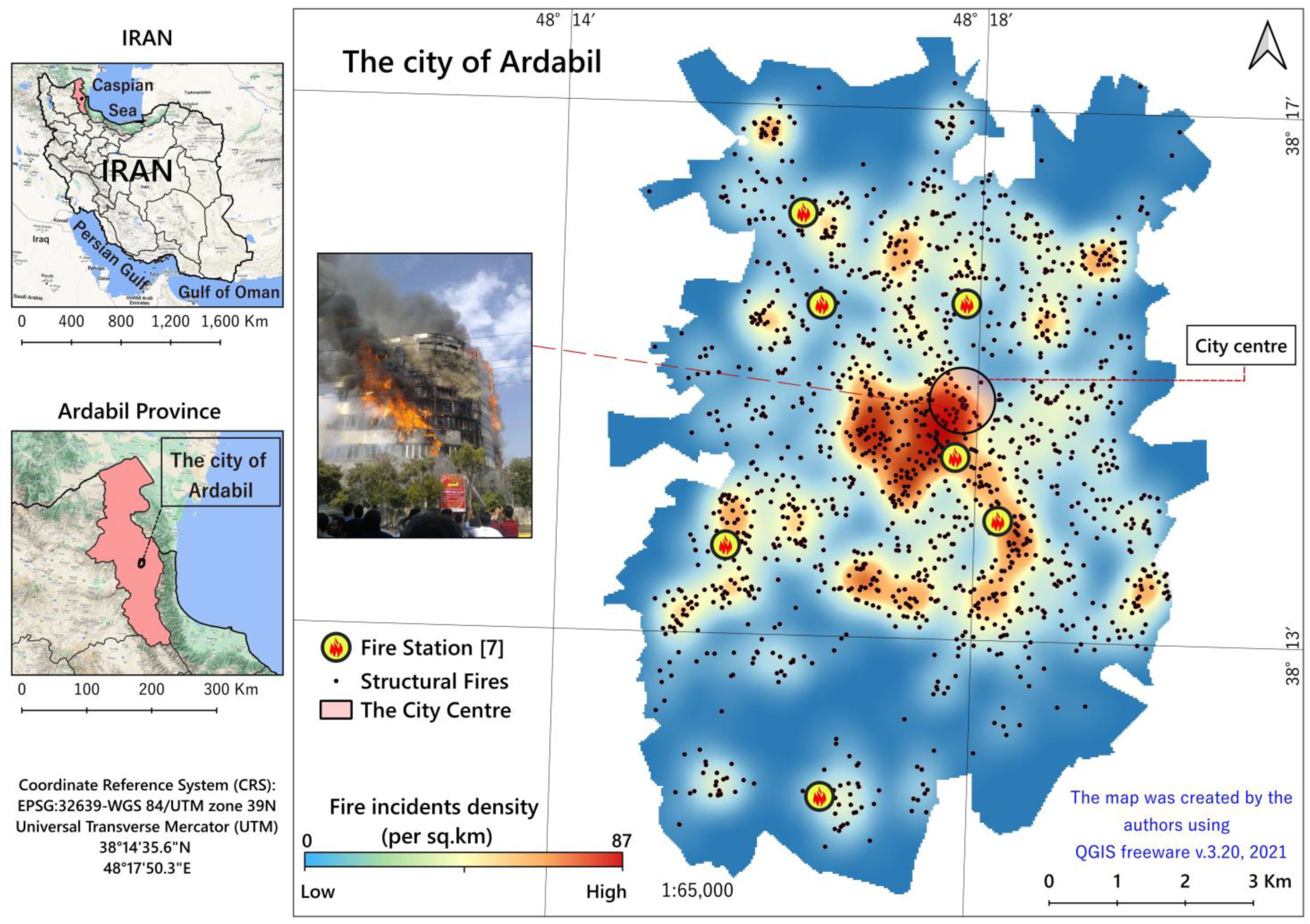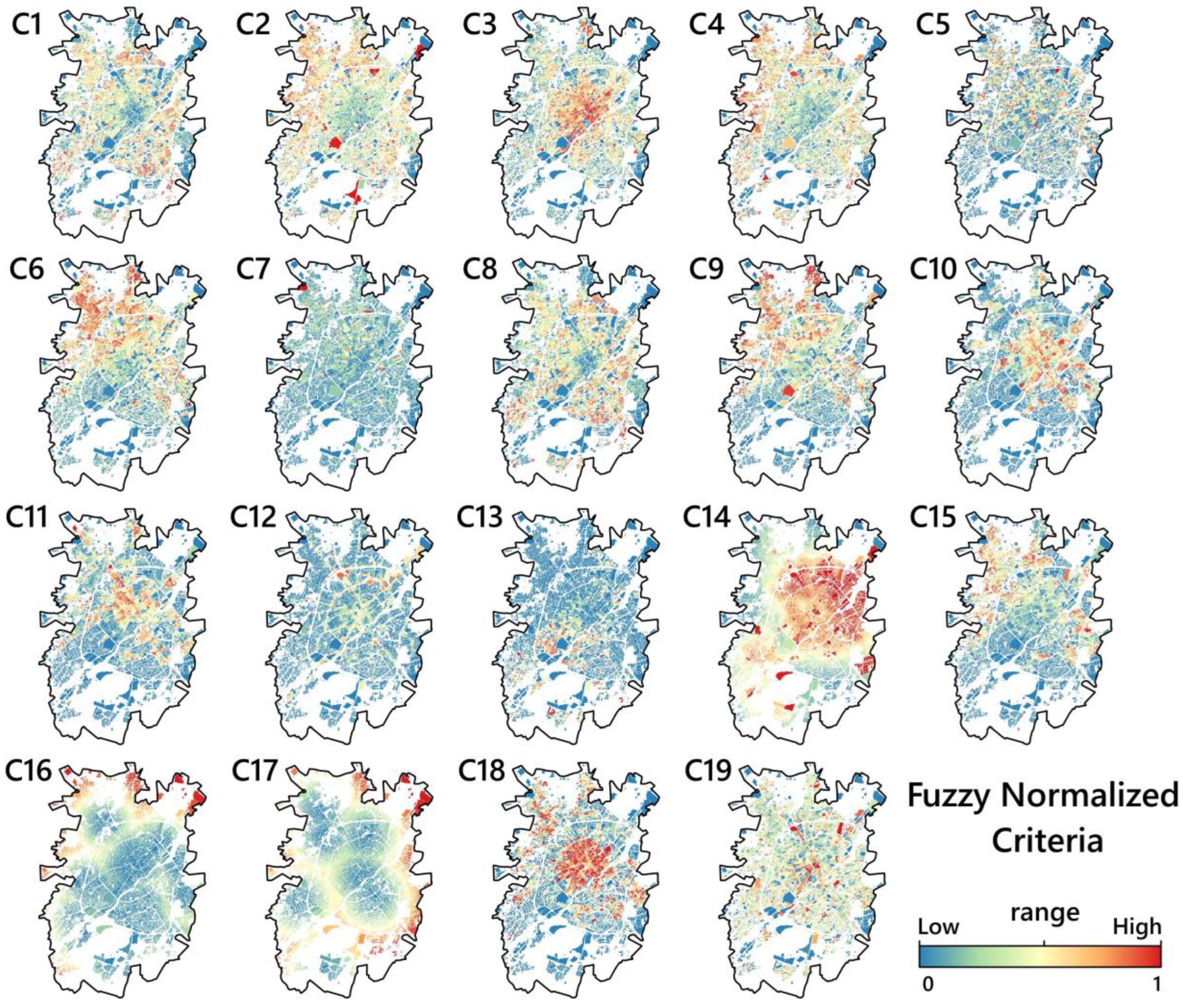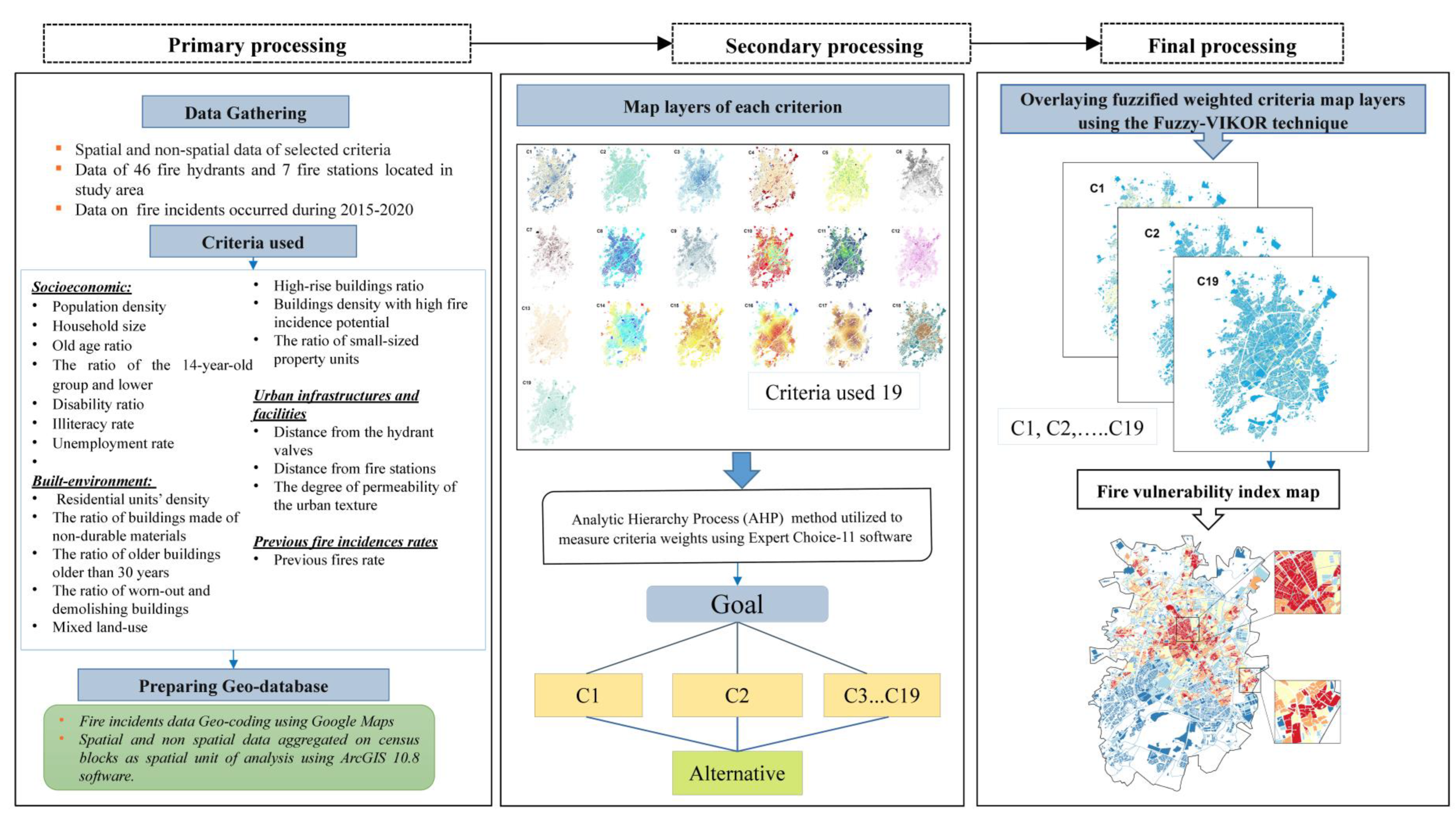Modelling and Mapping Urban Vulnerability Index against Potential Structural Fire-Related Risks: An Integrated GIS-MCDM Approach
Abstract
:1. Introduction
2. Materials and Methods
2.1. Study Area
2.2. Data
2.3. Methods, Tools, and Procedure
2.3.1. Criteria Ranking and Weighting
2.3.2. Fuzzy-VIKOR Method
2.3.3. Model Validation
3. Results
3.1. Urban Vulnerability Index Map
3.2. Model Performance
4. Discussion
4.1. Policy Implications
4.2. Limitations and Futures Research Strategy
5. Conclusions
Supplementary Materials
Author Contributions
Funding
Institutional Review Board Statement
Informed Consent Statement
Data Availability Statement
Acknowledgments
Conflicts of Interest
References
- Zhang, Y. Analysis on comprehensive risk assessment for urban fire: The case of Haikou City. Procedia Eng. 2013, 52, 618–623. [Google Scholar] [CrossRef] [Green Version]
- Kiran, K.C.; Corcoran, J. Modelling residential fire incident response times: A spatial analytic approach. Appl. Geogr. 2017, 84, 64–74. [Google Scholar]
- Zhang, X.; Yao, J.; Sila-Nowicka, K.; Jin, Y. Urban fire dynamics and its association with urban growth: Evidence from Nanjing, China. ISPRS Int. J. Geoinf. 2020, 9, 218. [Google Scholar] [CrossRef] [Green Version]
- Tishi, T.R.; Islam, I. Urban fire occurrences in the Dhaka Metropolitan Area. GeoJournal 2019, 84, 1417–1427. [Google Scholar] [CrossRef]
- World Health Organization (WHO). Burns. Published 30 January 2018. Available online: https://www.who.int/news-room/fact-sheets/detail/burns (accessed on 30 January 2023).
- Bickenbach, J. The world report on disability. Disabil. Soc. 2011, 26, 655–658. [Google Scholar] [CrossRef]
- Murillo, M.; Tutikian, B.F.; Christ, R.; Silva, L.F.; Maschen, M.; Oliveira, M.L. Analysis of the influence of thickness on fire reaction performance in polyisocyanurate core sandwich panels. J. Mater. Res. Technol. 2020, 9, 9487–9497. [Google Scholar] [CrossRef]
- Kaleji, L.K.; Murthy, K. The history of fire fighting in the Iran and the study spatial distribution of the current situation of fire stations and radius its function in Tehran city using GIS. Asian J. Dev. Matters 2011, 5, 207–218. [Google Scholar]
- Ceyhan, E.; Ertuğay, K.; Düzgün, Ş. Exploratory and inferential methods for spatio-temporal analysis of residential fire clustering in urban areas. Fire Saf. J. 2013, 58, 226–239. [Google Scholar] [CrossRef] [Green Version]
- Moshashaei, P.; Alizadeh, S.S. Fire risk assessment: A systematic review of the methodology and functional areas. Iran. J. Health Saf. Environ. 2017, 4, 654–669. [Google Scholar]
- Ziervogel, G.; Pelling, M.; Cartwright, A.; Chu, E.; Deshpande, T.; Harris, L.; Hyams, K.; Kaunda, J.; Klaus, B.; Michael, K.; et al. Inserting rights and justice into urban resilience: A focus on everyday risk. Environ. Urban 2017, 29, 123–138. [Google Scholar] [CrossRef] [Green Version]
- Oliveira, S.; Pereira, J.M.C.; San-Miguel-Ayanz, J.; Lourenço, L. Exploring the spatial patterns of fire density in Southern Europe using Geographically Weighted Regression. Appl. Geogr. 2014, 51, 143–157. [Google Scholar] [CrossRef]
- Aven, T. On Some Recent Definitions and Analysis Frameworks for Risk, Vulnerability, and Resilience. Risk Anal. 2011, 31, 515–522. [Google Scholar] [CrossRef] [PubMed]
- Alguacil, J. Instrumentos para el análisis y políticas para la acción. In Proceedings of the Foro de Debates: Ciudad y Territorio Jornada La Vulnerabilidad Urbana en España, Madrid, Spain, 30 June 2011; Volume 30. [Google Scholar]
- Huedo, P.; Ruá, M.J.; Florez-Perez, L.; Agost-Felip, R. Inclusion of Gender Views for the Evaluation and Mitigation of Urban Vulnerability: A Case Study in Castellón. Sustainability 2021, 13, 10062. [Google Scholar] [CrossRef]
- Guldåker, N.; Hallin, P.O. Spatio-temporal patterns of intentional fires, social stress and socio-economic determinants: A case study of Malmö, Sweden. Fire Saf. J. 2014, 70, 71–80. [Google Scholar] [CrossRef] [Green Version]
- Mohammadi, A.; Shahparvari, S.; Kiani, B.; Noori, S.; Chhetri, P. An analysis of Spatio–temporal patterns of fires in an Iranian city. Indoor Built Environ. 2022, 32, 183–199. [Google Scholar] [CrossRef]
- Cicione, A.; Gibson, L.; Wade, C.; Spearpoint, M.; Walls, R.; Rush, D. Towards the Development of a Probabilistic Approach to Informal Settlement Fire Spread Using Ignition Modelling and Spatial Metrics. Fire 2020, 3, 67. [Google Scholar] [CrossRef]
- Runefors, M.; Nilson, F. The Influence of Sociodemographic Factors on the Theoretical Effectiveness of Fire Prevention Interventions on Fatal Residential Fires. Fire Technol. 2021, 57, 2433–2450. [Google Scholar] [CrossRef]
- Shama, S.; Shurid, A.S.; Haque, M.N. Risk Assessment of Accidental Fire Breakdown in a Residential Area of Khulna City, Bangladesh. J. Eng. Sci. 2021, 12, 109–118. [Google Scholar] [CrossRef]
- Todorovic, S. Modelling risk factors in urban residential fires in Helsinki. Published online 2020. Available online: https://eprints.gla.ac.uk/210971/ (accessed on 1 February 2023).
- Xia, Z.; Li, H.; Chen, Y.; Yu, W. Detecting urban fire high-risk regions using colocation pattern measures. Sustain. Cities Soc. 2019, 49, 101607. [Google Scholar] [CrossRef]
- Bulai, A.T.; Roşu, L.; Bănică, A. Patterns of urban fire occurrence in Iasi City (Romania). Present Environ. Sustain. Dev. 2019, 2, 87–102. [Google Scholar] [CrossRef]
- Masoumi, Z.; van LGenderen, J.; Maleki, J. Fire risk assessment in dense urban areas using information fusion techniques. ISPRS Int. J. Geoinf. 2019, 8, 579. [Google Scholar] [CrossRef] [Green Version]
- Hu, J.; Shu, X.; Xie, S.; Tang, S.; Wu, J.; Deng, B. Socioeconomic determinants of urban fire risk: A city-wide analysis of 283 Chinese cities from 2013 to 2016. Fire Saf. J. 2019, 110, e102890. [Google Scholar] [CrossRef]
- Chhetri, P.; Corcoran, J.; Ahmad, S.; Kiran, K.C. Examining spatio-temporal patterns, drivers and trends of residential fires in South East Queensland, Australia. Disaster Prev. Manag. Int. J. 2018, 27, 586–603. [Google Scholar] [CrossRef]
- Ferreira, T.M.; Vicente, R.; da Silva, J.A.R.M.; Varum, H.; Costa, A.; Maio, R. Urban fire risk: Evaluation and emergency planning. J. Cult. Herit. 2016, 20, 739–745. [Google Scholar] [CrossRef] [Green Version]
- Hastie, C.; Searle, R. Socio-economic and demographic predictors of accidental dwelling fire rates. Fire Saf. J. 2016, 84, 50–56. [Google Scholar] [CrossRef] [Green Version]
- Rahmawati, D.; Pamungkas, A.; Aulia, B.U.; Larasati, K.D.; Rahadyan, G.A.; Dito, A.H. Participatory mapping for urban fire risk reduction in high-density urban settlement. Procedia-Soc. Behav. Sci. 2016, 227, 395–401. [Google Scholar] [CrossRef] [Green Version]
- Ardiantoa, R.; Chhetria, P.; Dunstallb, S. Modelling the Likelihood of Urban Residential Fires Considering Fire History and the Built Environment: A Markov Chain Approach. In Proceedings of the 21st International Congress on Modelling and Simulations, Queensland, Australia, 29 November–4 December 2015; Available online: https://www.mssanz.org.au/ (accessed on 30 January 2023).
- Shahparvari, S.; Fadaki, M.; Chhetri, P. Spatial accessibility of fire stations for enhancing operational response in Melbourne. Fire Saf. J. 2020, 117, 103149. [Google Scholar] [CrossRef]
- Kiran, K.C. Temporal and spatial patterns of fire incident response time: A case study of residential fires in Brisbane. In Proceedings of the 7th State of Australian Cities Conference, Gold Coast, Australia, 9–11 December 2015; Available online: https://apo.org.au/node/63305 (accessed on 28 January 2023).
- Špatenková, O.; Virrantaus, K. Discovering spatio-temporal relationships in the distribution of building fires. Fire Saf. J. 2013, 62, 49–63. [Google Scholar] [CrossRef]
- Corcoran, J.; Higgs, G.; Higginson, A. Fire incidence in metropolitan areas: A comparative study of Brisbane (Australia) and Cardiff (United Kingdom). Appl. Geogr. 2011, 31, 65–75. [Google Scholar] [CrossRef]
- Wuschke, K.; Clare, J.; Garis, L. Temporal and geographic clustering of residential structure fires: A theoretical platform for targeted fire prevention. Fire Saf. J. 2013, 62, 3–12. [Google Scholar] [CrossRef]
- Ardianto, R.; Chhetri, P. Modeling Spatial–Temporal dynamics of urban residential fire risk using a Markov Chain technique. Int. J. Disaster Risk Sci. 2019, 10, 57–73. [Google Scholar] [CrossRef] [Green Version]
- Chu, G.Q.; Chen, T.; Sun, Z.H.; Sun, J.H. Probabilistic risk assessment for evacuees in building fires. Build. Environ. 2007, 42, 1283–1290. [Google Scholar] [CrossRef]
- Lee, C.A.; Sung, Y.C.; Lin, Y.S.; Hsiao, G.L.K. Evaluating the severity of building fires with the analytical hierarchy process, big data analysis, and remote sensing. Nat. Hazards 2020, 103, 1843–1856. [Google Scholar] [CrossRef]
- Alkış, S.; Aksoy, E.; Akpınar, K. Risk Assessment of Industrial Fires for Surrounding Vulnerable Facilities Using a Multi-Criteria Decision Support Approach and GIS. Fire 2021, 4, 53. [Google Scholar] [CrossRef]
- Silva, D.; Rodrigues, H.; Ferreira, T.M. Assessment and Mitigation of the Fire Vulnerability and Risk in the Historic City Centre of Aveiro, Portugal. Fire 2022, 5, 173. [Google Scholar] [CrossRef]
- Chen, Y.; Wu, G.; Chen, Y.; Xia, Z. Spatial Location Optimization of Fire Stations with Traffic Status and Urban Functional Areas. Appl. Spat. Anal. Policy 2023, 1–18. [Google Scholar] [CrossRef]
- Alizadeh, M.; Hashim, M.; Alizadeh, E.; Shahabi, H.; Karami, M.R.; Pour, A.B.; Pradhan, B.; Zabihi, H. Multi-Criteria Decision Making (MCDM) Model for Seismic Vulnerability Assessment (SVA) of Urban Residential Buildings. ISPRS Int. J. Geoinf. 2018, 7, 444. [Google Scholar] [CrossRef] [Green Version]
- Maniatis, Y.; Doganis, A.; Chatzigeorgiadis, M. Fire Risk Probability Mapping Using Machine Learning Tools and Multi-Criteria Decision Analysis in the GIS Environment: A Case Study in the National Park Forest Dadia-Lefkimi-Soufli, Greece. Appl. Sci. 2022, 12, 2938. [Google Scholar] [CrossRef]
- Jiang, Y.; Lv, A.; Yan, Z.; Yang, Z. A GIS-Based Multi-Criterion Decision-Making Method to Select City Fire Brigade: A Case Study of Wuhan, China. ISPRS Int. J. Geoinf. 2021, 10, 777. [Google Scholar] [CrossRef]
- Statistical Centre of Iran. Ardabil Province Housing and Population Census Reports and Data. Available online: https://www.amar.org.ir/english (accessed on 20 February 2023).
- Ardabil City Fire Department. Annual Report of Fire Events and Rescue in Ardabil City. Available online: https://fire.ardabilcity.ir/ (accessed on 10 February 2023).
- QGIS Development Team. QGIS Geographic Information System, Version 3.26. Available online: http://qgis.osgeo.org (accessed on 10 February 2023).
- Anselin, L.; Syabri, I.; Kho, Y. GeoDa: An introduction to spatial data analysis. In Geographical Analysis; Springer: Berlin/Heidelberg, Germany, 2006; Volume 38, pp. 5–22. [Google Scholar] [CrossRef]
- Anselin, L.; Lozano, N.; Koschinsky, J. Rate transformations and smoothing. Urbana 2006, 51, 61801. [Google Scholar]
- Environmental Systems Research Institute (ESRI). ArcGIS Professional GIS. Available online: http://http//pro.arcgis.com (accessed on 4 January 2023).
- ESRI. ArcGIS Pro Help. Available online: https://pro.arcgis.com/en/pro-app/latest/help/main/welcome-to-the-arcgis-pro-app-help.htm (accessed on 1 November 2022).
- Saaty, T.L. Principles of the analytic hierarchy process. In Expert Judgment and Expert Systems; Springer: Berlin/Heidelberg, Germany, 1987; pp. 27–73. [Google Scholar]
- Saaty, T.L. An Exposition of the AHP in Reply to the Paper “Remarks on the Analytic Hierarchy Process”. Manag. Sci. 1990, 36, 259–268. [Google Scholar] [CrossRef]
- Gumus, S. An evaluation of stakeholder perception differences in forest road assessment factors using the Analytic Hierarchy Process (AHP). Forests 2017, 8, 165. [Google Scholar] [CrossRef] [Green Version]
- Akkas, O.P.; Erten, M.Y.; Cam, E.; Inanc, N. Optimal Site Selection for a Solar Power Plant in the Central Anatolian Region of Turkey. Int. J. Photoenergy 2017, 2017, 7452715. [Google Scholar] [CrossRef] [Green Version]
- de Smith, M.J.; Goodchild, M.F.; Longley, P. Geospatial Analysis: A Comprehensive Guide to Principles, Techniques and Software Tools; Troubador publishing Ltd.: Market Harborough, UK, 2007. [Google Scholar]
- Clark Labs. The TerrSet Help System. Clark University, 2022. Available online: https://clarklabs.org/download/ (accessed on 2 May 2022).
- Sternlieb, G.; Burchell, R.; Fires in Abandoned Buildings. The Social and Economic Consequences of Residential Fires Lexington, MA: Lexington Books. 1983. Available online: https://mbln.bibliocommons.com/v2/record/S75C2055156 (accessed on 1 May 2022).
- Jennings, C.R. Social and economic characteristics as determinants of residential fire risk in urban neighborhoods: A review of the literature. Fire Saf. J. 2013, 62, 13–19. [Google Scholar] [CrossRef]
- Kuran, C.H.A.; Morsut, C.; Kruke, B.I.; Krüger, M.; Segnestam, L.; Orru, K.; Nævestad, T.-O.; Airola, M.; Keränen, J.; Gabel, F.; et al. Vulnerability and vulnerable groups from an intersectionality perspective. Int. J. Disaster Risk Reduct. 2020, 50, 101826. [Google Scholar] [CrossRef]
- Al-Yasiri, H.Q.M. Trends in the illiteracy rate in Iraq and its regional neighborhood for the period 2010–2020. Misan J. Acad. Stud. 2021, 20. Available online: https://www.iasj.net/iasj/article/215027 (accessed on 20 February 2023).
- Young, A.O. Cohort Size and Unemployment Rate: New Insights from Nigeria. Glob. J. Emerg. Mark. Econ. 2021, 13, 122–151. [Google Scholar] [CrossRef]
- Ni, S.; Gernay, T. A framework for probabilistic fire loss estimation in concrete building structures. Struct. Saf. 2021, 88, 102029. [Google Scholar] [CrossRef]
- Dadzie, J.; Ding, G.; Runeson, G. Relationship between sustainable technology and building age: Evidence from Australia. Procedia Eng. 2017, 180, 1131–1138. [Google Scholar] [CrossRef]
- Lago, A.; Faridani, H.M.; Trabucco, D. Damping Technologies for Tall Buildings, 1st ed.; Butterworth-Heinemann: Woburn, MA, USA, 2018; ISBN 9780128159644. [Google Scholar]
- Winandari, M.I.R.; Wijayanto, P.; Faradila. Fire risk based on building density in dense settlement. IOP Conf.Ser. Earth Environ. Sci. 2021, 780, 12053. [Google Scholar] [CrossRef]
- Raškauskaitė, R.; Grigonis, V. An Approach for the Analysis of the Accessibility of Fire Hydrants in Urban Territories. ISPRS Int. J. Geo-Inf. 2019, 8, 587. [Google Scholar] [CrossRef] [Green Version]
- Cruz, M.G.; Hurley, R.J.; Bessell, R.; Sullivan, A.L. Fire behaviour in wheat crops-effect of fuel structure on rate of fire spread. Int. J. Wildl. Fire 2020, 29, 258–271. [Google Scholar] [CrossRef]






| Criteria | Statistics | ||||||
|---|---|---|---|---|---|---|---|
| Symbol | Criterion | Min | Max | Mean | SD | AHP Weights | Fuzzy Membership Function |
| C1 | Population density | 0 | 86.1 | 2.03 | 2.22 | 0.032 | linear s-shaped |
| C2 | Household dimension | 0 | 10.7 | 0.24 | 0.22 | 0.022 | linear s-shaped |
| C3 | Old age ratio | 0 | 50 | 3.55 | 4.40 | 0.031 | linear s-shaped |
| C4 | The ratio of the 14-year-old group and lower | 0 | 50 | 11.81 | 8.90 | 0.035 | linear s-shaped |
| C5 | Disability ratio | 0 | 91.73 | 0.98 | 2.55 | 0.036 | linear s-shaped |
| C6 | Illiteracy rate | 0 | 91.46 | 8.23 | 8.49 | 0.02 | linear s-shaped |
| C7 | Unemployment rate | 0 | 0.34 | 1.48 | 2.25 | 0.019 | linear s-shaped |
| C8 | Residential units’ density | 0 | 287 | 58.69 | 66.59 | 0.031 | linear s-shaped |
| C9 | The ratio of buildings made of non-durable materials | 0 | 100 | 10.71 | 19.79 | 0.069 | linear s-shaped |
| C10 | The ratio of older buildings older than 30 years | 0 | 100 | 13.80 | 24.12 | 0.051 | linear s-shaped |
| C11 | The ratio of worn-out and demolishing buildings | 0 | 100 | 19.74 | 26.85 | 0.099 | linear s-shaped |
| C12 | Mixed land-use | 0 | 0.71 | 0.04 | 0.10 | 0.055 | linear s-shaped |
| C13 | High-rise buildings ratio | 0 | 100 | 2.34 | 8.48 | 0.049 | linear s-shaped |
| C14 | Buildings density with high fire incidence potential | 0.84 | 4.88 | 2.88 | 0.46 | 0.114 | linear s-shaped |
| C15 | The ratio of small-sized property parts | 0 | 100 | 23.16 | 30.63 | 0.033 | linear s-shaped |
| C16 | Euclidean distance from the hydrant valves | 0 | 3907.24 | 949.05 | 660.7 | 0.066 | linear s-shaped |
| C17 | Euclidean distance from fire stations | 0 | 4091.57 | 1352.56 | 686 | 0.08 | linear s-shaped |
| C18 | The degree of permeability of the urban texture | 0 | 100 | 29.65 | 38.83 | 0.079 | linear s-shaped |
| C19 | Previous fires rate | 0 | 555 | 17.87 | 29.31 | 0.078 | linear s-shaped |
| Vulnerability Degree | Vulnerability Score | Number of Blocks | Area (sq.km) | Area (%) | Population | Population (%) |
|---|---|---|---|---|---|---|
| Higher | 0.086–0.35 | 639 | 4.11 | 13.62 | 72,471 | 13.83 |
| High | 0.35–0.48 | 930 | 5.26 | 17.43 | 106,716 | 20.37 |
| Moderate | 0.48–0.6 | 945 | 5.31 | 17.59 | 104,254 | 19.90 |
| Low | 0.6–0.74 | 1282 | 5.97 | 19.78 | 103,797 | 19.81 |
| Lower | 0.74–1 | 2941 | 9.53 | 31.58 | 136,663 | 26.09 |
Disclaimer/Publisher’s Note: The statements, opinions and data contained in all publications are solely those of the individual author(s) and contributor(s) and not of MDPI and/or the editor(s). MDPI and/or the editor(s) disclaim responsibility for any injury to people or property resulting from any ideas, methods, instructions or products referred to in the content. |
© 2023 by the authors. Licensee MDPI, Basel, Switzerland. This article is an open access article distributed under the terms and conditions of the Creative Commons Attribution (CC BY) license (https://creativecommons.org/licenses/by/4.0/).
Share and Cite
Noori, S.; Mohammadi, A.; Miguel Ferreira, T.; Ghaffari Gilandeh, A.; Mirahmadzadeh Ardabili, S.J. Modelling and Mapping Urban Vulnerability Index against Potential Structural Fire-Related Risks: An Integrated GIS-MCDM Approach. Fire 2023, 6, 107. https://doi.org/10.3390/fire6030107
Noori S, Mohammadi A, Miguel Ferreira T, Ghaffari Gilandeh A, Mirahmadzadeh Ardabili SJ. Modelling and Mapping Urban Vulnerability Index against Potential Structural Fire-Related Risks: An Integrated GIS-MCDM Approach. Fire. 2023; 6(3):107. https://doi.org/10.3390/fire6030107
Chicago/Turabian StyleNoori, Sepideh, Alireza Mohammadi, Tiago Miguel Ferreira, Ata Ghaffari Gilandeh, and Seyed Jamal Mirahmadzadeh Ardabili. 2023. "Modelling and Mapping Urban Vulnerability Index against Potential Structural Fire-Related Risks: An Integrated GIS-MCDM Approach" Fire 6, no. 3: 107. https://doi.org/10.3390/fire6030107
APA StyleNoori, S., Mohammadi, A., Miguel Ferreira, T., Ghaffari Gilandeh, A., & Mirahmadzadeh Ardabili, S. J. (2023). Modelling and Mapping Urban Vulnerability Index against Potential Structural Fire-Related Risks: An Integrated GIS-MCDM Approach. Fire, 6(3), 107. https://doi.org/10.3390/fire6030107







